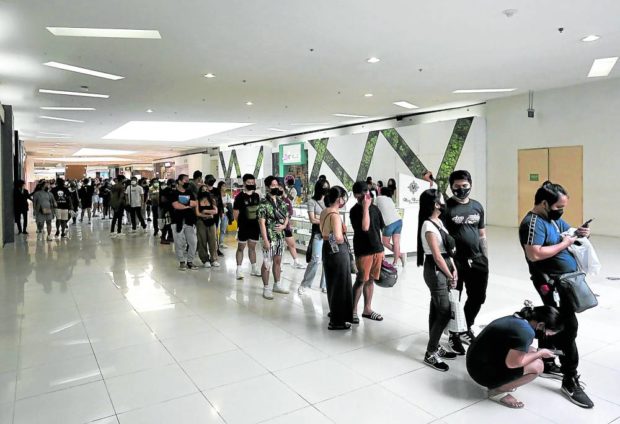With positivity rate at record 44%, PH posts highest daily COVID tally of 28,707

FILM BUG “Spider-Man: No Way Home” draws long queues of moviegoers at a Pasay City mall even as new COVID-19 infections topped 28,000 on Sunday. —RICHARD A. REYES
MANILA, Philippines — A record 28,707 new COVID-19 cases were reported by the Department of Health (DOH) on Sunday, the highest daily tally since the start of the pandemic two years ago, amid the presumed community transmission of the highly contagious Omicron variant.
Two out of every five, or a record 44 percent, of the 77,479 people who got tested last Jan. 7 were positive for COVID-19, according to the DOH.
The number of new cases could be higher as 14 laboratories were not able to submit their results to the COVID-19 Document Repository System.
With total confirmed cases now at 2,965,447, the country is expected to breach the 3 million mark in a day or two.
The DOH also confirmed 15 more deaths due to COVID-19 from September 2021 to January this year, bringing the confirmed death toll to 52,150.
Article continues after this advertisementActive cases, or people still infected with the virus, climbed to 128,114, although the vast majority, or 96.4 percent, of them were mild (119,276) or asymptomatic (4,213). Of those who were still sick, 309 were critically ill, 1,465 severely ill, and 2,851 moderately ill.
Article continues after this advertisementNearly 60 percent of the new cases detected in the past two weeks (Dec. 27, 2021, to Jan. 9 this year) were in the National Capital Region, 20 percent in Calabarzon (Cavite, Laguna, Batangas, Rizal, and Quezon), and 10 percent in Central Luzon, according to the DOH.
With the majority of confirmed cases reported in Metro Manila, hospital admissions have also sharply increased over the past week.
COVID-19 intensive care beds in the capital region were now 52 percent full (against 35 percent at the national level), half of the isolation beds were occupied (39 percent at the national level), and 65 percent of ward beds were in use (38 percent nationwide).
Twenty-six percent of ventilators available for Metro Manila COVID-19 patients with respiratory problems were also in use, against 18 percent at the national level.
As the demand for COVID-19 tests surged following the spike of new infections, health authorities said no self-administered antigen test kits applied for market use have so far been approved by the regulatory agency Food and Drug Administration (FDA).
The DOH insisted that rapid antigen tests must be administered by healthcare professionals and used on symptomatic COVID-19 patients, close contacts, and those with a history of exposure in areas with outbreaks.
“Currently, there are no FDA approved COVID-19 self-testing kits. The FDA has not approved any of the self-administered antigen kits,” Health Undersecretary Maria Rosario Vergeire said last Friday.
Accurate results
“The administering of antigen tests should be done by trained healthcare workers in order to ensure accurate results,” she stressed.
The DOH said rapid antigen tests required a nasal swab “which is difficult to do.”
The more expensive laboratory reverse transcription polymerase chain reaction (RT-PCR) swab test, regarded as a gold standard in the diagnosis of COVID-19, is the DOH’s accepted test for the virus.
“The government will still have to discuss this matter (of self-administered test kits) with the experts,” Vergeire said.
The DOH also admitted on Friday that there were reports from hospitals and laboratories of an increasing number of healthcare workers infected with COVID-19.
“For the laboratories, they are now implementing a maximum number of swabbing per day to ensure continued operations and protect the healthcare workers at the same time,” Vergeire said.